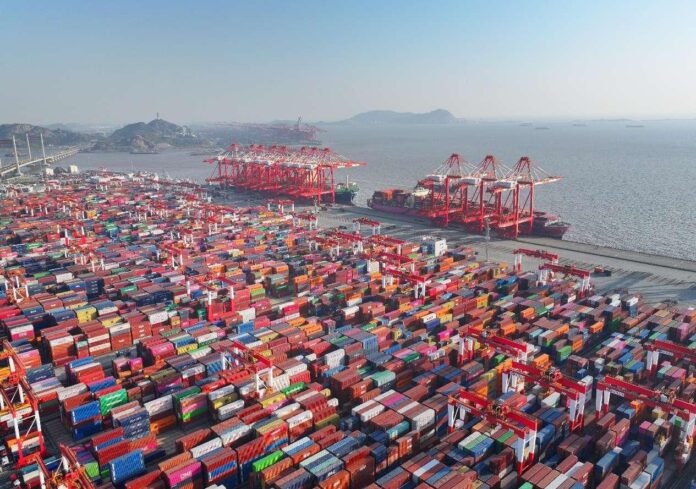Introduction: An Era of Automation
As global trade continues to expand, the demand for efficient and streamlined logistics operations has never been greater. One country leading this transformation is China, where automated ports are emerging as key players in the advancement of logistics technology. In particular, the recent events at Qingdao Port in Shandong province, where a ship laden with cargo docked at a fully automated terminal, stand as a testament to the potential of intelligent maritime operations.
Automated Container Terminals: The Qingdao Example
At approximately 9 a.m., a ship arrived at the Qingdao Port, initiating a seamless loading and unloading process underscored by automation. As the ship docked, specialized gantry cranes, towering high above the terminal, expertly grasped and positioned containers onto Automated Guided Vehicles (AGVs). The precision and speed were evident as high-speed rail-mounted gantry cranes moved efficiently through the yard, ensuring a well-organized stacking system for incoming containers.
Construction of this revolutionary terminal began in 2015 and was executed in three phases, with the third phase becoming operational by the end of 2023. According to port officials, this state-of-the-art terminal has boosted operational efficiency by 6% and throughput by 15%, showcasing the vital role automation plays in modern logistics.
Record-Breaking Productivity
The impact of these innovations is reflected in the statistics. On January 1, 2025, the automated container terminal at Qingdao Port logged an impressive average productivity rate of 60.9 units per hour per crane during loading operations, marking the 12th time it has set a world record in efficiency for automated terminals globally. This achievement not only emphasizes the prowess of automated systems but also underlines the potential for increased productivity in the maritime sector.
Unmanned Operations: The Yantai Port Model
Heading north along the coastline, Yantai Port presents another compelling case for the effectiveness of automation. At its ore terminal, operations are conducted entirely without human intervention. As an orange ship unloader swings into action, mechanical arms extract cargo from the ship, while conveyor belts facilitate rapid loading and unloading processes. The incorporation of fully automated terminal control technology has elevated the efficiency of unloading and loading operations by more than 20% compared to traditional methods.
Visualizing Automation in Action
The accompanying images of automated terminals at both Qingdao and Yantai Ports showcase the advanced technologies at play, reflecting the seamless coordination and efficiency of unmanned operations. These ports epitomize the successful implementation of automation, marking China as a leader in port technology.
National Progress: China’s Automated Port Landscape
According to the Ministry of Transport, China has constructed a total of 52 fully automated container and bulk cargo terminals, ranking first in the world for both completed and under-construction projects. This remarkable growth is not coincidental; recent policies and standards related to automated terminal design and operations have spurred development, leading to innovative technologies being employed not only domestically but also abroad.
The Role of Key Players
Li Yiming, a director at Shanghai Zhenhua Heavy Industries, elaborates on the critical components necessary for achieving full-scale automation at ports. Key equipment such as dual-trolley quay cranes and AGVs are essential for maximizing loading and unloading efficiency. At the Yangshan phase IV automated terminal in Shanghai, for instance, the efficiency of operations has surged by leveraging drones capable of lifting two containers simultaneously.
Robust Software Systems: The Backbone of Automation
Efficiency in automation doesn’t solely depend on hardware; the role of automation software cannot be underestimated. At the Meishan port area of Ningbo-Zhoushan Port, a robust software system enables real-time management of various port machinery. This advanced technology allows for precise scheduling, fostering seamless coordination of hundreds of AGVs, cranes, and loaders, thus optimizing overall port performance.
Contributing to Economic Growth
In 2024, Ningbo-Zhoushan Port reported a cargo throughput of 1.268 billion tons, reflecting a 3.27% increase from the previous year, along with a substantial rise in container throughput. Such figures illustrate the substantial economic impact that automation has at ports, contributing to greater efficiency and capacity in China’s maritime logistics.
Conclusion: A Future of Smart Ports
As automation takes a firm hold in Chinese ports, the country continues to drive forward the concept of intelligent logistics. From Qingdao to Yantai, the integration of technology is setting new benchmarks for productivity and efficiency in maritime operations. With the construction of more automated terminals and the continued development of advanced technologies, China stands on the threshold of a new era in the logistics sector. The smooth operations witnessed today are just the beginning, as the future of smart ports unfolds, promising even greater innovations in the years to come.














